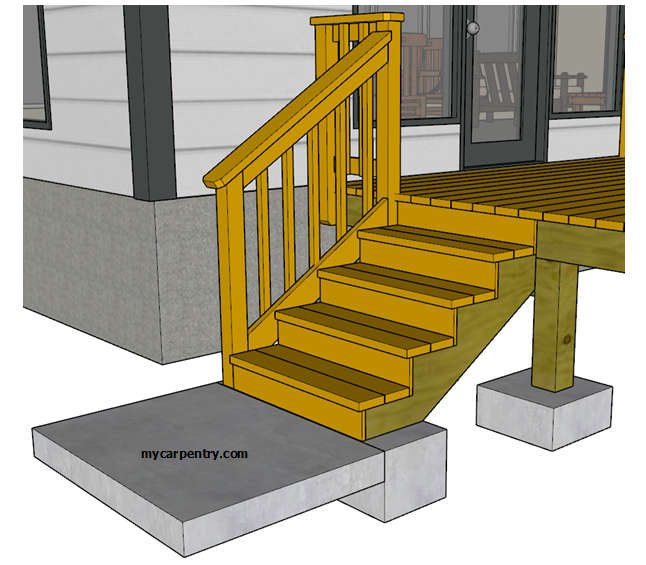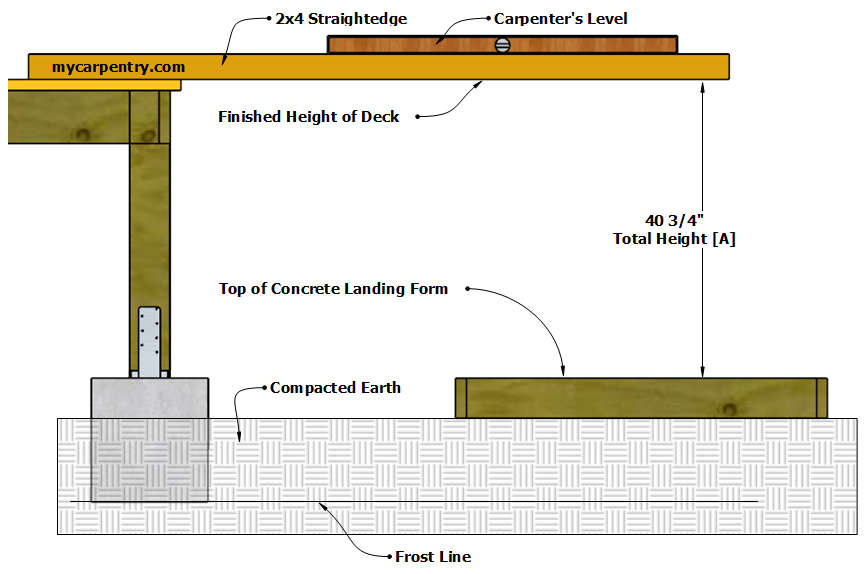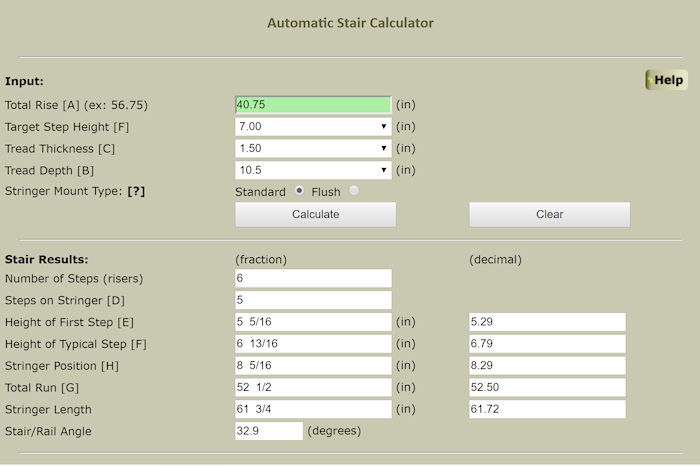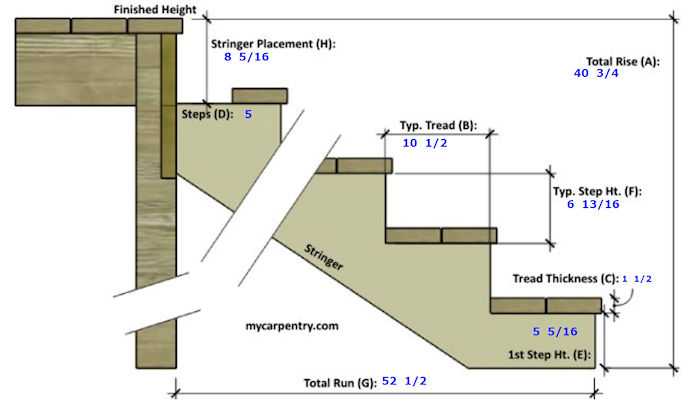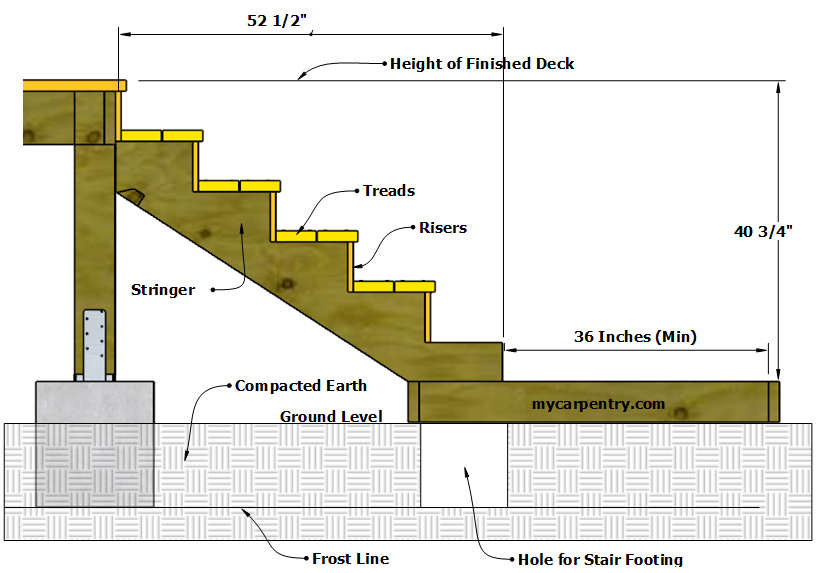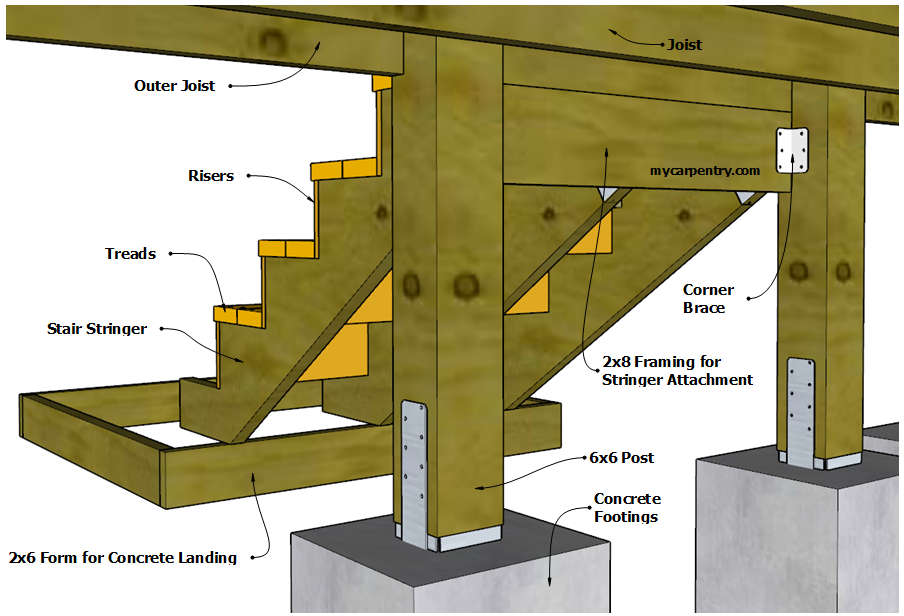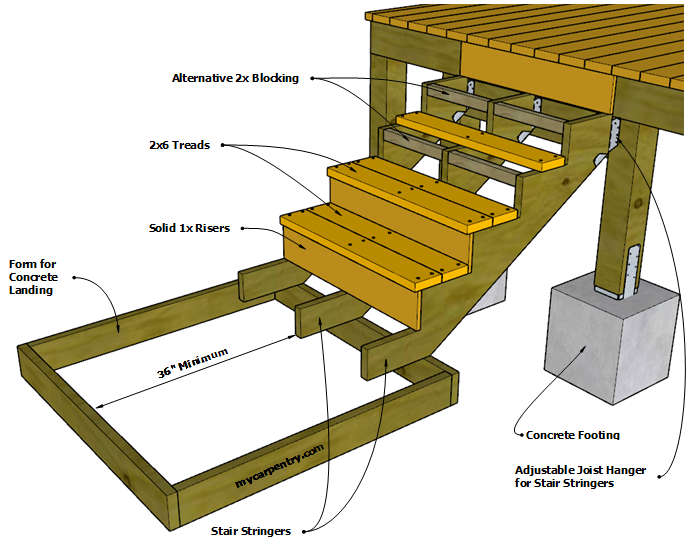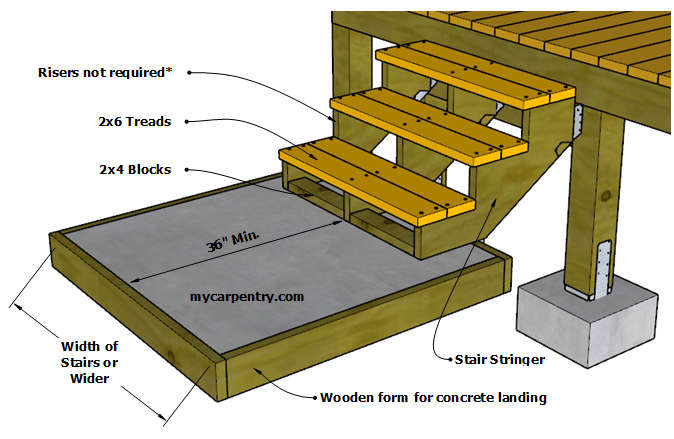Building Deck Stairs (5)
Building Deck Stairs (phase 5 of 7) - If your deck is more than 10 inches off the ground, you will probably need stairs (even if it is only a single step).
Stair building articles on mycarpentry.com discuss two ways to attach stairs to a deck or landing - either the flush mount, where the top step on the stringer is attached flush with the level of the deck surface, or the standard mount, where the top step of the stringer is attached a full step height below the deck or landing. Either method is acceptable. But when building deck stairs, I prefer the standard mount.
Building Deck Stairs
The first step to building deck stairs is to measure the Total Rise of the stairs. This measurement is from the lowest point of the stair stringer to the deck surface. For a short run of stairs, I usually use a straightedge (with a level on top) that is long enough to lay on top of the deck surface and extend over the area where the stairs will start. Use a tape measure to measure the vertical distance between the two elevations.
In this example, there is a concrete landing at the base of the stairs. The width and depth of the concrete landing pad must be a minimum of 36" (915 mm). Our concrete landing is 48" x 48" (1219 mm) because it will also support the base of the stringers and the rail posts, discussed in the Stair Railing tutorial. (Note: The minimum landing width must be the same as the width of the stairs.)
The Total Rise from the top of the wooden form to the finished deck height is 40 3/4" (1035 mm). Navigate to the Stair Calculator and enter 40.75 into the Total Rise [A] field. If you accept all default input values, the following results will appear.
Use the Total Run results provided by the stair calculator (52 1/2") to align the wooden form for the concrete landing. The footing beneath the base of the stringers must extend to a depth of 12 inches below the ground's surface or to the frost line. The landing must be a minimum of 36 inches (914 mm) from the face of the first step (see diagram below). The width must be no less than the width of the stairs.
You can use wooden stakes (nailed to the outside of the form) to hold it in place and keep it square, level, and aligned with the deck frame. But before laying out and cutting the stringers, double-check the Total Rise [A] again. If it has changed, run it through the Stair Calculator again to recalculate the rise and run.
Install support posts and footings on the deck at the location of the deck stairs, indicated in the drawing below. The posts should be a minimum of 36" apart (the minimum width of a run of stairs). Install 2x8 (min) framing between posts (to support the upper end of the stair stringers) directly under the outside joist of the deck. Add corner bracing to the new framing member, as shown in the diagram below.
On the outside of the deck, at the location of the stairs, measure down 8 5/16" (Stair Calculator results - Stringer Position [H]) from the finished height of the deck on each side of where the stringers will be attached, and make a mark with a carpenter's pencil. Using a level or a straight edge, draw a level line to connect the two crow's foot marks. This line will be the height of the top step of the stringers. Note: Once you add the treads to the stringers, this step will be the same height as the other steps (Typical Step [F]).
Attach a stringer to each side of the deck framing up to the level line using an approved joist hanger. The stringers should be no less than 36" (915 mm) (outside-to-outside) apart. Attach the remaining stringer centered between the two outer ones. Cut two 2x4 blocks to place between stringers on the first step of the stairs. Use concrete anchors to secure the blocks to the slab. These blocks will hold the bottoms of the stair stingers in place on the concrete landing.
As an alternative to solid risers, you can use 2x blocking between each step on the stringers to comply with the building code that states that a 4" sphere should not pass between the treads on deck stairs greater than 30".
You can build stairs wider than 36" but additional stringers will likely be required. The additional stringers should be spaced evenly between the outer stringers and not more than 18" (457 mm) apart.
If your finished deck height is under 30", continue to the next section below. If not, please continue to Stair Railing for best practices for adding stair railing to your deck.
Stairs for Low Deck Heights (less than 30")
The diagram below shows stairs with no risers. On decks under 30" in height, risers are not needed..
The diagram above shows the finished stairs with concrete already poured, so you can see how the stairs are aligned and attached to a lower landing. If your stairs have a Total Rise [A] of 30" (762 mm) or more (and our example does), a stair rail or guard is required. You would need to set the lower handrail posts before pouring the concrete.
These are the basics of building deck stairs. To continue with the handrail design and construction, navigate to Stair Railing.
** Note: For building code information related to stair construction, visit 2024 International Residential Code for One- and Two-Family Dwellings - Section 318 - MEANS OF EGRESS.
For building code information related to deck construction, check out the Prescriptive Residential Wood Deck Construction Guide by the American Wood Council.
Stair Railing - Learn how to build stair railing.
Carpentry Tools - Find tools used for building decks.
Carpentry Calculators - Calculators for Carpentry.
Building Decks - "I have built over 200 decks."
What next?
Continue to Step 6 (of 7) - (Railing)
Visit Stairs with Landings to learn how to add landings to your stair design.
Leave Building Deck Stairs and return Home.


